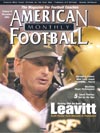AMERICAN FOOTBALL MONTHLY THE #1 RESOURCE FOR FOOTBALL COACHES
Article CategoriesAFM Magazine
|
The Science of Recruiting Letters - Part IIWhat Every Coach Must Know© More from this issue Whether you like it or not, recruiting is a necessity. It is the only means to rebuild fallen programs and reload successful ones. More often than not, recruiting has become an endless saga filled with repetitive approaches that have changed little in the past four decades. Recruiting is something that everyone does, but does everyone do it well? In last month’s issue, the staff of American Football Monthly pooled their ideas – and a few handy phone numbers – and talked recruiting with some of the top recruiting coordinators in the country from Division I-A to I-AA, Division II to III and NAIA to Juco. AFM talked with Georgia and Mississippi State (I-A), Alcorn State....The full article can only be seen by subscribers. Subscribe today!
|
|
|||||||
| HOME |
MAGAZINE |
SUBSCRIBE | ONLINE COLUMNISTS | COACHING VIDEOS |
Copyright 2025, AmericanFootballMonthly.com
All Rights Reserved





